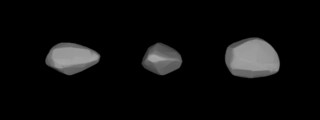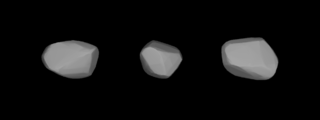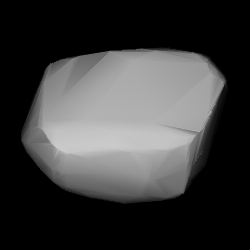Related Research Articles

Klytia is a main-belt asteroid. It was the second and last asteroid discovery by the prolific comet discoverer Horace Tuttle, on April 7, 1862. It is named after Clytia, who loved Helios in Greek mythology. Of the first one hundred numbered asteroids, Klytia is the smallest.

Aethra is a metallic asteroid and Mars-crosser on an eccentric orbit from the asteroid belt. It measures approximately 40 kilometers in diameter.

Tolosa is a brightly coloured, stony background asteroid from the inner region of the asteroid belt. It was discovered by French astronomer Henri Joseph Perrotin on 19 May 1874, and named by the Latin and Occitan name of the French city of Toulouse.

199 Byblis is a medium-sized main belt asteroid.

Amherstia was the 8th asteroid discovered by Raymond Smith Dugan, and was named after Amherst College, his alma mater. Amherstia is a large M-type main belt asteroid, with an estimated diameter of 73 km. It follows an eccentric orbit between Jupiter and Mars, with an orbital period of 4.39 years. The orbital plane is inclined at an angle of 13° to the ecliptic.

Germania is a very large main-belt asteroid. It is classified as a B-type asteroid and is probably composed of dark, primitive carbonaceous material.

Chicago is a very large main-belt asteroid. It is classified as a C-type asteroid and is probably composed of carbonaceous material.

Desiderata is a very large main-belt asteroid. It is classified as a C-type asteroid and is probably composed of carbonaceous material.

Vaticana is a large Main belt asteroid.
Edna is a large Main belt asteroid.
Bruchsalia is a main-belt asteroid. It was discovered by Max Wolf and Friedrich Karl Arnold Schwassmann on May 22, 1900. Its provisional name was 1900 FG.
Emita is a minor planet orbiting the Sun that was discovered by the Italian astronomer Luigi Carnera on February 12, 1902. The meaning of the asteroid's proper name remains unknown.
Marion is a minor planet orbiting the Sun. It was discovered by Raymond Smith Dugan in February 1903, and was later named after a cousin of his. It is designated as a C-type asteroid with a size of approximately 104 kilometres (64.6 mi).

Princetonia is a large asteroid, a type of minor planet, orbiting in the asteroid belt. It was discovered by Raymond Smith Dugan at Heidelberg, Germany in 1903 and named "Princetonia" for Princeton University in New Jersey in the United States.
Centesima is a 50 km Main-belt asteroid orbiting the Sun. It is one of the core members of the Eos family of asteroids. Relatively little is known about this tiny asteroid. It is not known to possess any natural satellites, so its mass is unknown. However, its brief rotation period of just over 5 hours implies that the body must be exceptionally dense, for its gravity is able counteract the centrifugal force. It was discovered 24 August 1903 by late-nineteenth- and early-twentieth-century astronomer Max Wolf. It was his 100th asteroid discovery, hence the name, which in Latin, means "hundredth".
Brixia is a relatively large minor planet, specifically an asteroid orbiting mostly in the asteroid belt that was discovered by American astronomer Raymond Smith Dugan on January 10, 1904. The name derives from Brixia, the ancient name of the Italian city of Brescia.

Sylvania is a minor planet orbiting the Sun in the main belt. It was discovered on 20 October 1903 by American astronomer R. S. Dugan at the Heidelberg observatory. The name is Latin for forest lands. 519 Sylvania is orbiting the Sun at a distance of 2.79 AU with an eccentricity (ovalness) of 0.186 and a period of 4.66 yr. The orbital plane is inclined at an angle of 11.0° to the ecliptic. This S-type (stony) asteroid has an estimated diameter of 48 km and is revolving with a period of 17.962 h.
Ada is a minor planet orbiting the Sun. It was discovered January 29, 1904, by American astronomer Raymond S. Dugan at Heidelberg, Germany and was named after his friend Ada Helme. CCD images collected during the fall of 2004 at Oakley Observatory in Terre Haute, Indiana, were used to generate a lightcurve for the object, showing a rotation period of 10.03 ± 0.01 hours.
Montague is a minor planet orbiting the Sun that was discovered by Raymond Smith Dugan on 7 May 1904 in Heidelberg, Germany. It was named after the town Montague in Massachusetts.

690 Wratislavia is a minor planet orbiting the Sun. Wratislavia was discovered on October 16, 1909. IRAS data shows it is about 135 km in diameter.
References
- 1 2 "503 Evelyn (1903 LF)". JPL Small-Body Database . NASA/Jet Propulsion Laboratory . Retrieved 9 May 2016.
- 1 2 3 Carry, B. (December 2012), "Density of asteroids", Planetary and Space Science, vol. 73, pp. 98–118, arXiv: 1203.4336 , Bibcode:2012P&SS...73...98C, doi:10.1016/j.pss.2012.03.009. See Table 1.